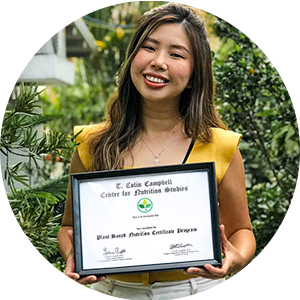
Lose weight, lower your cholesterol, and reduce your risk of heart disease within a few short months, just by improving how you eat. Sounds like an ad, right?
But my husband, 61, and I, 59, have checked off all three daunting goals in just four months after plunging into a whole foods, plant-based diet—and even though we live in Ithaca, NY, a haven for healthy eaters, we never thought we’d join the ranks of our city’s vegans.
Just before Thanksgiving a catheterization of my husband’s heart revealed four blockages, one of which was of critical concern. Until then, we had been fortunate enough to coast through life in good health with few medical interventions, and certainly no life-threatening ones. Yet, twenty-four hours after a procedure that sounded alarms, we were on a hospital cardiac ward in nearby Rochester listening to a leading regional cardiac surgeon describe the triple-bypass operation he would perform on my husband’s heart the very next morning.
In short, it was this crisis, followed by a long and uncomfortable surgical recovery, that vaulted us swiftly into choosing a whole foods, plant-based diet. So far, we’ve adopted this healthier way of eating and dining without regrets or looking back.
My husband’s doctors no doubt had saved his life, preemptively diagnosing heart disease and preventing him from suffering what surely might have been a damaging or even fatal heart attack. Expert nutritionists at Ithaca’s Cayuga Heart Institute set us on the pathway of whole foods, plant-based eating in order to keep those vital currents of blood flowing freely in and out of my husband’s heart.
Before consulting with nutritionists, I had banked on common sense approaches like consuming less meat and lowering salt intake. Certainly the recommendation of a whole foods, plant-based diet was a far more aggressive strategy than we’d been expecting. We went home after the first consultation armed with the names of books and articles by T. Colin Campbell, Caldwell Esselstyn, Dean Ornish, and other advocates of plant-based eating for good health and disease prevention. In fact, it was also recommended that we follow Esselstyn’s advice to eliminate all oils and plant-based foods with higher levels of oil such as nuts and avocadoes— or as we think of it: plant-based eating to the nth degree; a vegan diet on steroids.
Giving up oil may seem drastic, but if there’s a reasonable chance it can reduce and reverse heart disease, it’s not too big a step to take. Still, even to me, a long-time vegetarian and enthusiastic chef, his regimen seemed daunting.
But my husband, emphatic in his desire to never again need heart surgery, was highly motivated. As partner and chef, I was along for the ride as a very willing passenger and ally. It wasn’t strictly necessary that I adhere to the same diet, but I knew that it would be easier and more motivating for my husband to stick with it if we were in it together. Besides, I was intrigued. Working at Cornell University, I was already familiar with Dr. Campbell’s work and had heard him speak. Still, preparing meals based on a plant-based diet for myself alone while cooking other meals for preferences of family members had seemed impractical. Now, the best choice was not only clear, but also prescriptive.
Our transition was both shorter and easier than I expected, in part because we had already been eating vegetarian at home for several years. Going plant-based was just one more step; going oil-free meant adapting many of my tried-and-true and largely plant-based recipes by simply dry roasting, steaming, and sautéing foods in water.
That’s not to say our new diet does not come with challenges or to discount a certain amount of self-discipline. When my right hand reaches forward, say, for a slew of salty fries or a slice of cake with creamy frosting, my left hand must snatch it away. For example, we travel a lot, and it can be tricky to find good plant-based meals on the road. It takes advance research and crowdsourcing information from friends to find suitable restaurants. It also means, whenever possible, packing the car or carry-on luggage with enough substenance to get us through our journey. We can’t just grab a quick slice of pizza or drive into any fast food hotspot.
However, we’re not only making it work, but also eating some extremely delicious food. My husband says he just tries not to think about the pulled pork, pepperoni pizza, cheeseburgers, and other foods he enjoyed for many years. I can honestly report I do not feel either deprived, nor do I feel an unsatisfied hunger—and I can feed my late night cravings with healthy crackers, cereal, or frozen ices that seem to do the trick. Added bonus: the heavy feeling from eating foods that are rich in fat and calories is gone.
After just four months he dropped 15 pounds, while I dropped 10, and we both significantly lowered our HDL cholesterol. So far the results speak for themselves, and we’re expecting more good outcomes to follow.
More silver linings with our whole foods, plant-based diet:
Copyright 2024 Center for Nutrition Studies. All rights reserved.
